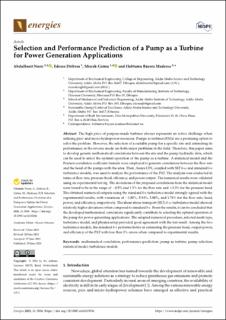| dc.description.abstract | The high price of purpose-made turbines always represents an active challenge when utilizing pico- and micro-hydropower resources. Pumps as turbines (PATs) are a promising option to solve the problem. However, the selection of a suitable pump for a specific site and estimating its performance in the reverse mode are both major problems in the field. Therefore, this paper aims to develop generic mathematical correlations between the site and the pump hydraulic data, which can be used to select the optimal operation of the pump as a turbine. A statistical model and the Pearson correlation coefficient formula were employed to generate correlations between the flow rate and the head of the pumps with the sites. Then, Ansys CFX, coupled with SST k-ω and standard k-ε turbulence models, was used to analyze the performance of the PAT. The analysis was conducted in terms of flow rate, pressure head, efficiency, and power output. The numerical results were validated using an experimental test rig. The deviations of the proposed correlations from the statistical model were found to be in the range of −0.2% and 1.5% for the flow rate and ±3.3% for the pressure head. The obtained numerical outputs using the standard k-ε turbulence model strongly agreed with the experimental results, with variations of −1.82%, 2.94%, 2.88%, and 1.76% for the flow rate, head, power, and efficiency, respectively. The shear stress transport (SST) k-ω turbulence model showed relatively higher deviations when compared to standard k-ε. From the results, it can be concluded that the developed mathematical correlations significantly contribute to selecting the optimal operation of the pump for power-generating applications. The adopted numerical procedure, selected mesh type, turbulence model, and physics setup provided good agreement with the test result. Among the two turbulence models, the standard k-ε performs better in estimating the pressure head, output power, and efficiency of the PAT with less than 3% errors when compared to experimental results. | en_US |

